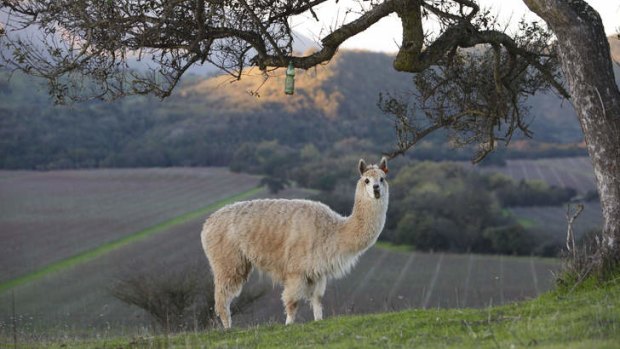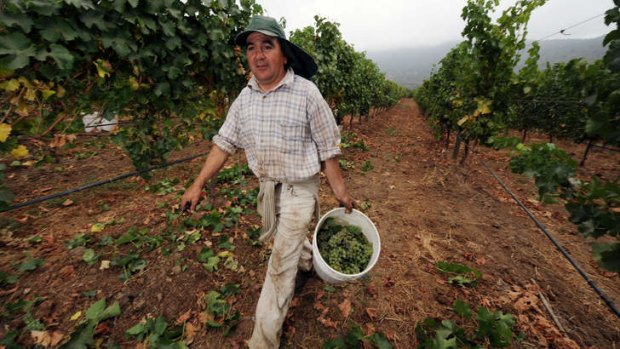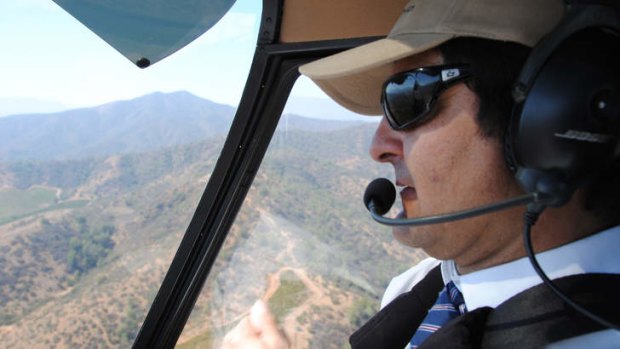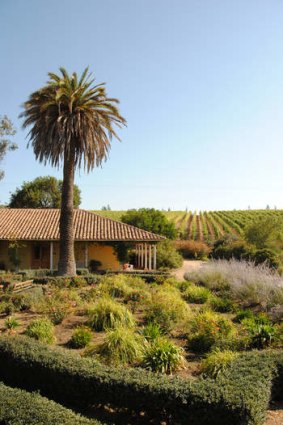
Alpaca crop the weeds between lines of grapes.Credit: Alamy
Stunning scenery makes a helicopter tour of the country's wineries a vintage experience for Anthony Dennis.
A grissini is a long, thin pretzel-like Italian snack that makes a perfect accompaniment to a glass of vino. I'm reminded of it, strangely, since Chile, where I find myself hovering at several hundred feet above terra firma, is the only nation on Earth to resemble a breadstick. It's so long and thin that, by looking at it on the map, you could seemingly snap it in half and dip it in the Pacific, or at least have one of those periodically devastating earthquakes perform the task for you.
But Chile's odd geographical shape - at no point is it any wider than 180 kilometres - has its advantages. On this clear-as-a-just-squeezed-sauvignon-blanc day, I'm treated to an awesome sight from the unobstructed vantage point of the perspex-encased front seat of a small and nimble helicopter. It's hovering above the South American nation's Casablanca and San Antonio valleys, conveniently located between its two largest cities, Santiago and Valparaiso.

A worker carries a bucket with bunches of Sauvignon Blanc stock grapes, in the Emiliana vineyard.Credit: AFP
The chopper is piloted by a member of the local Diaz vigneron family, and while I'm meant to be paying attention to the patchwork of undulating dry-straw- and bottle-green-coloured vineyards below me, my gaze is mainly fixed elsewhere. Around me to the west is the Pacific Ocean, while to the east are the Andes Mountains, which, not so far from here, form the rugged border between Chile and Argentina.
I figure that I can see the gleaming sun-drenched, snow-white summit of Aconcagua, the highest mountain in the Americas at just under 7000 metres, which rises above the adjoining peaks that nudge it. I'm on a day-long wine tour in two of Chile's most famous, and blessedly low-key, wine regions with the combination of the Pacific Ocean and the Andes, along with cold rainy winters and warm, dry summers providing the perfect environment for cool-climate wines.
Clearly, what with the involvement of heavy-duty hardware such as a helicopter, this tour is no crummy cellar-door and designated-driver-type affair. It's a private wine and chopper tour, operated by an experienced, upscale outfit named Santiago Adventures, which specialises in day trips to the abundance of easily accessed wine regions that surround the sprawling capital of 6 million-plus residents.

The tour's helicopter pilot.Credit: Anthony Dennis
The helicopter ride is provided to save tour participants the dreadful inconvenience of having to access the adjacent valley by road. It's a pricey tour: a 1976 bottle of Grange is cheaper than this trip, should you go it alone. But the specialist itinerary is carefully tailored for time-challenged wine enthusiasts, as not only does it highlight the kind of premium organic and biodynamic wines for which Chile has not been instantly known, it also provides a rare audience with the winemakers.
For slightly nervy helicopter passengers such as me, at least on this tour there is the reassuring bonus of a therapeutic glass of premium wine at the end of the 20-minute flight to the next winery.
My day began at my hotel in Santiago where I was greeted by my guide and driver (of a car). After an hour or so of easy driving from Santiago, our first stop in a fog-bound Casablanca Valley, a cool-climate region known for its white and red varietals, is at an organic winery named Emiliana. At this hour there is hardly anyone around aside from a caretaker wandering through the mist in a fetching straw Chilean sombrero - a hat smaller and stiffer than the floppy Mexican variety.

Wined up: Matetic winery's La Casona hacienda.
As I approach the strikingly modern cellar door, I pass a small herd of llama that is encouraged to wander between the vines and fertilise the soil, which Chilean winemakers believe enhances their drops. After a short visit to Emiliana, we travel to Loma Larga Vineyards, which, two years ago, was named "winery of the year" by the influential US-based Wine & Spirits magazine. The winery, with its rustic and leafy setting amid a complex of old low-level hacienda-like buildings, is known for producing quality cool-climate reds, such as malbec and syrah. Remarkably, the modern Chilean wine industry is even younger than that of Australia, with the Casablanca Valley having been developed in the past quarter of a century.
I've embarked on this illuminating tour with only a rudimentary knowledge of Chilean wine. I was aware that Chilean drops, as was once the case with the Australian equivalent before the rise of the dollar and over-planting, represent exceptional value and reasonable quality.
I know, too, that Chilean wines have become a major competitor for the once-affordable Australian drops (though I was, however, entirely unaware of the organic benefits of llama poo). Lower labour and production costs, and a competitive exchange rate, provide an enviable market advantage for the Chileans.
What most distinguishes Chilean wine is the ubiquity of the carmenere grape - the sixth member of the cabernet sauvignon family and whose origins can be traced to Bordeaux. Chile's geography and diverse climate zones provide ideal growing conditions for many wine varieties in addition to carmenere: sauvignon blanc, chardonnay, syrah, pinot noir, cabernet sauvignon, carignan and malbec, a favourite of the Argentinians.
Unlike their Australian counterparts, Chilean wineries, surprisingly, are normally off limits to casual visitors and it's often necessary to make an appointment, and pay an admission fee of between $US15 and $US40 ($14-$38). It's why the tour I'm doing has such appeal. After a personalised tour of the estate by the French-born winemaker, who for a time worked in Australia, and a private tasting of the Loma Larga range, it's time to take to the air for the trip to the San Antonio Valley.
Drink-driving laws are strict in Chile, with blood-alcohol levels exceeding the equivalent of a single glass of wine (more than 0.03 per cent) resulting in immediate arrest and car confiscation, according to American-born founder of Santiago Adventures, Brian Pearson.
"In Chile, the wine routes aren't well marked, so arriving on your own can be a challenge," Pearson says. "The distance between wineries is longer and it is difficult to visit more than three wineries per day, with a nice lunch along the way. Not all wineries offer the same experience to the international visitor, so it is important to choose those that offer good wines and knowledgeable hosts for the best experience."
When I arrive at Matetic vineyards by chopper, I'm transferred to the main working part of the winery, near where grapes are being hand-picked and packed in the lavish sunshine by a small army of workers. Beside them is parked their transport, an ancient green bus with "San Antonio" on its destination board, which lends the scene a faint Grapes of Wrath air.
As was the case at Loma Larga, I'm afforded a private tasting with the winemaker. Both of the winemakers at Loma Larga and Matetic - one a Frenchman, Cedric Nicolle, the other Chilean, Julio Bastias - politely assume that I possess more wine knowledge than I do, but I manage to make it through the sessions without being exposed as the dilettante I surely am.
Elsewhere, the modernity of Matetic's state-of-the-art winemaking operation is contrasted by its elegant seven-room lodgings, La Casona, a century-old hacienda-style complex adjacent to the vines. I wish I could stay the night (or three) rather than having to head back to Santiago. By the time I sit down for lunch, consisting of American-sized servings, and yes, more Chilean wine, at the pond-side restaurant at Matetic vineyards, it's mid-afternoon.
It's been a full itinerary, to say the least. And while not intoxicated, I am certainly feeling like I've overindulged a little on vital information related to the Chilean wine industry.
This has been no tour for the "I-don't-know-much-about-wine-but-know-what-I-like"-type visitor to Chile. Sadly, as I bid adios to the San Antonio Valley there's no helicopter to whisk me back to the city.
But I do at least have a designated driver, a belly full of the finest Chilean wines and the bonus of having ogled the Andes from a great height in all of their towering glory.
Anthony Dennis is national travel editor of Fairfax Media. He travelled to Chile as a guest of Qantas, Tourism Chile and Santiago Adventures.
FAST FACTS
Getting there Qantas has a fare to Santiago for about $1780 low-season return from Sydney including taxes. Qantas operates three non-stop flights a week, taking 12hr 30min on a refurbished Boeing 747-400ER. On the other days of the week you travel with a QF flight number but on a LAN aircraft. Melbourne passengers pay about $100 more and fly to Sydney or Auckland (depending on the day) to connect. Phone 13 13 13, see qantas.com.au.
Touring there The Casablanca & San Antonio Valley Heli Wine Tour is conducted for up to three people by Santiago Adventures. Prices start from $US456 ($433) a person, which includes private transportation to and from your Santiago-based accommodation, a bilingual guide, tours of the Loma Larga and Matetic vineyards with premium tastings and lunch at Matetic. Santiago Adventures operates a range of other affordable wine tours. See santiagoadventures.com.
Staying there The Aubrey, Constitucion 299-317, Bellavista, Santiago, +56 229 402 800, is Australian- and British-owned and is widely regarded as Santiago's most stylish and well-located boutique hotels. It's in the lively Bellavista restaurant and bar district. Rooms are priced from $US240. See theaubrey.com.
More information www.emiliana.cl; lomalarga.com; matetic.cl; chile.travel.
Sign up for the Traveller Deals newsletter
Get exclusive travel deals delivered straight to your inbox. Sign up now.